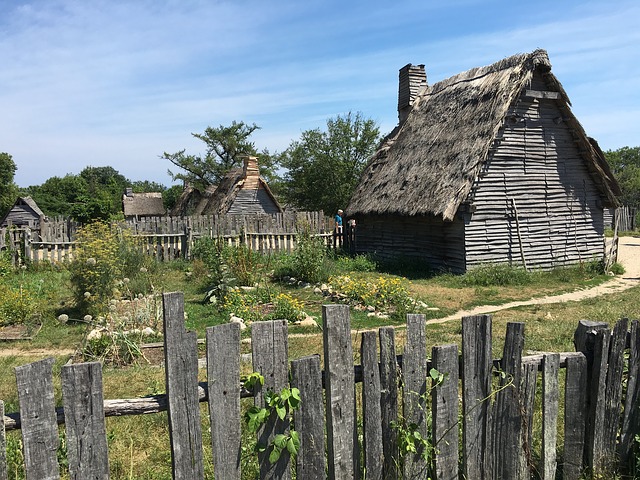By Tim Lambert
Homes in Colonial New England
The first houses in New England were simple wooden huts. They had timber frames covered in clapboard with thatched roofs. Rather than glass windows had sheets of paper soaked in oil. The first chimneys were of logs covered in plaster – an obvious fire hazard! The earliest houses were crowded, dark, and drafty.

However, people soon built more substantial houses. As they grew more prosperous they added new rooms. They also replaced oiled paper with glass windows.
In the late 17th century the main room in a prosperous New England home was called the keeping room. It was used as a living room and a dining room. In it, carpets were placed on tables (they were too valuable to put on the floor!). Chairs were a luxury and often only dad had one. The rest of the family sat on benches. They used chests for storage.
In New Amsterdam buildings were, at first, made of wood but in time houses of stone or brick were erected. Thatched roofs were banned in 1657 (because of the risk of fire). Dutch settlers built houses in the same style as those at home.
Colonial Food and Drink
In the 17th century, it was usually unsafe to drink water, it was too dirty. At first, colonists were forced to use corn to make an alcoholic drink. Later beer and cider were common. For the wealthy wine and brandy were imported. For ordinary people, rum became a popular drink in the late 17th century. In the 18th century, tea became popular.
In the early 17th century colonists relied mainly on corn for food. It was made into bread or mush or was eaten with beans in a meal called succotash. Later in the 17th century, other grains like rye, wheat, and barley were grown. Colonists also grew vegetables like onions, turnips, parsnips, and carrots. If meat was available stew was a popular meal.

In the 17th century, few people used forks although they became common in the 18th century. In the 17th century, it was common for two or more people to share a wooden plate called a trencher.
Clothing in Colonial New England
At the beginning of the 17th century, men wore starched collars called ruffs. Women wore frames made of wood or whalebone under their dresses. However, the farthingale was soon discarded and the ruff evolved into a large lace collar (for those who could afford it!).
In the 17th century, men wore knee-length garments called breeches. They also wore stockings and boots.
On the upper body men wore linen shirts. In the early 17th century they wore a kind of jacket called a doublet with a cape on top. Men wore their hair long. They also wore beards.
In the late 17th century a man’s doublet became a waistcoat and men wore a frock coat over it. With breeches, it was rather like a three-piece suit. Men were now clean-shaven and they wore wigs.
Women wore a linen garment called a shift. Over it, they wore long dresses. The dress was in two parts the bodice and the skirt. Sometimes women wore two skirts. The upper skirt was gathered up to reveal an underskirt. Women in the 17th century did not wear panties.
Work in Colonial New England
Most people in New England lived by farming. It was back-breaking work and usually lasted from dawn to dusk. However in the south by the 18th century, great plantations existed alongside the many small farms. From 1612 tobacco was grown in Virginia and in 1619 the first black slaves arrived. At first, slaves were rare but during the late 17th century they became more and more common especially in the south.
In North America, there were the same craftsmen found in Europe such as carpenters, coopers, tanners, millers, and blacksmiths. Apothecaries sold drugs.
17th Century Medicine
During the 17th century operations were performed by barber-surgeons. Their knowledge of anatomy improved. Medicine also improved. In 1628 William Harvey published his discovery of how blood circulates around the body. Doctors also discovered how to treat malaria with bark from the cinchona tree.
However, medicine was still handicapped by wrong ideas about the human body. Most doctors still thought that there were four fluids or ‘humors’ in the body, blood, phlegm, yellow bile, and black bile. Illness resulted when you had too much of one humor. Nevertheless, during the 17th century, a more scientific approach to medicine emerged and some doctors began to question traditional ideas.
The average lifespan in the 17th century was shorter than today. The average life expectancy at birth was only 35. That does not mean that people dropped dead when they reached that age! Instead many of the people born died while they were still children. Out of all people born between one third and one half died before the age of about 16. However, if you could survive to your mid-teens you would probably live to your 50s or early 60s. Even in the 17th century, a few people did live to their 70s or 80s.
Last revised 2024